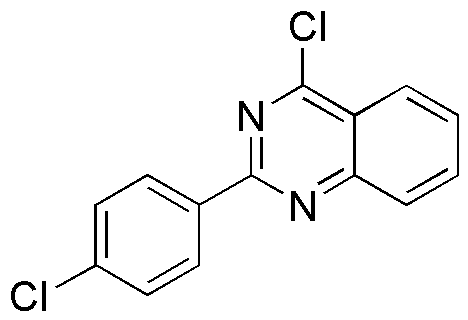4-Chloro-2-(4-chlorophenyl)quinazoline is widely utilized in research focused on:
- Pharmaceutical Development: This compound serves as a key intermediate in the synthesis of various pharmaceuticals, particularly in the development of anti-cancer agents. Its structure allows for modifications that enhance therapeutic efficacy.
- Biochemical Research: It is used in studies exploring cellular pathways and mechanisms of action in cancer cells, helping researchers understand drug resistance and potential targets for new therapies.
- Agricultural Chemistry: The compound finds applications in the formulation of agrochemicals, particularly as a pesticide or herbicide, due to its effectiveness against specific plant pathogens.
- Material Science: It is explored for its potential use in developing novel materials, such as polymers or coatings, that require specific chemical properties for enhanced durability and performance.
- Analytical Chemistry: This compound is used as a standard in analytical methods, aiding in the detection and quantification of related compounds in various samples, ensuring quality control in manufacturing processes.
General Information
Properties
Safety and Regulations
Applications
4-Chloro-2-(4-chlorophenyl)quinazoline is widely utilized in research focused on:
- Pharmaceutical Development: This compound serves as a key intermediate in the synthesis of various pharmaceuticals, particularly in the development of anti-cancer agents. Its structure allows for modifications that enhance therapeutic efficacy.
- Biochemical Research: It is used in studies exploring cellular pathways and mechanisms of action in cancer cells, helping researchers understand drug resistance and potential targets for new therapies.
- Agricultural Chemistry: The compound finds applications in the formulation of agrochemicals, particularly as a pesticide or herbicide, due to its effectiveness against specific plant pathogens.
- Material Science: It is explored for its potential use in developing novel materials, such as polymers or coatings, that require specific chemical properties for enhanced durability and performance.
- Analytical Chemistry: This compound is used as a standard in analytical methods, aiding in the detection and quantification of related compounds in various samples, ensuring quality control in manufacturing processes.
Documents
Safety Data Sheets (SDS)
The SDS provides comprehensive safety information on handling, storage, and disposal of the product.
Product Specification (PS)
The PS provides a comprehensive breakdown of the product’s properties, including chemical composition, physical state, purity, and storage requirements. It also details acceptable quality ranges and the product's intended applications.
Certificates of Analysis (COA)
Search for Certificates of Analysis (COA) by entering the products Lot Number. Lot and Batch Numbers can be found on a product’s label following the words ‘Lot’ or ‘Batch’.
*Catalog Number
*Lot Number
Certificates Of Origin (COO)
This COO confirms the country where the product was manufactured, and also details the materials and components used in it and whether it is derived from natural, synthetic, or other specific sources. This certificate may be required for customs, trade, and regulatory compliance.
*Catalog Number
*Lot Number
Safety Data Sheets (SDS)
The SDS provides comprehensive safety information on handling, storage, and disposal of the product.
DownloadProduct Specification (PS)
The PS provides a comprehensive breakdown of the product’s properties, including chemical composition, physical state, purity, and storage requirements. It also details acceptable quality ranges and the product's intended applications.
DownloadCertificates of Analysis (COA)
Search for Certificates of Analysis (COA) by entering the products Lot Number. Lot and Batch Numbers can be found on a product’s label following the words ‘Lot’ or ‘Batch’.
*Catalog Number
*Lot Number
Certificates Of Origin (COO)
This COO confirms the country where the product was manufactured, and also details the materials and components used in it and whether it is derived from natural, synthetic, or other specific sources. This certificate may be required for customs, trade, and regulatory compliance.


